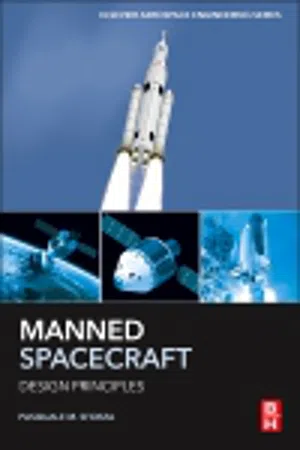
- 647 pages
- English
- ePUB (mobile friendly)
- Available on iOS & Android
Manned Spacecraft Design Principles
About this book
Manned Spacecraft Design Principles presents readers with a brief, to-the-point primer that includes a detailed introduction to the information required at the preliminary design stage of a manned space transportation system.In the process of developing the preliminary design, the book covers content not often discussed in a standard aerospace curriculum, including atmospheric entry dynamics, space launch dynamics, hypersonic flow fields, hypersonic heat transfer, and skin friction, along with the economic aspects of space flight.Key concepts relating to human factors and crew support systems are also included, providing users with a comprehensive guide on how to make informed choices from an array of competing options. The text can be used in conjunction with Pasquale Sforza's, Commercial Aircraft Design Principles to form a complete course in Aircraft/Spacecraft Design.- Presents a brief, to-the-point primer that includes a detailed introduction to the information required at the preliminary design stage of a manned space transportation system- Involves the reader in the preliminary design of a modern manned spacecraft and associated launch vehicle- Includes key concepts relating to human factors and crew support systems- Contains standard, empirical, and classical methods in support of the design process- Culminates in the preparation of a professional quality design report
Frequently asked questions
- Essential is ideal for learners and professionals who enjoy exploring a wide range of subjects. Access the Essential Library with 800,000+ trusted titles and best-sellers across business, personal growth, and the humanities. Includes unlimited reading time and Standard Read Aloud voice.
- Complete: Perfect for advanced learners and researchers needing full, unrestricted access. Unlock 1.4M+ books across hundreds of subjects, including academic and specialized titles. The Complete Plan also includes advanced features like Premium Read Aloud and Research Assistant.
Please note we cannot support devices running on iOS 13 and Android 7 or earlier. Learn more about using the app.
Information
Manned Spaceflight
Abstract
Keywords
1.1 Where Space Begins



1.2 Staying in Space

Table of contents
- Cover image
- Title page
- Table of Contents
- Copyright
- Preface
- Introduction and Outline of a Spacecraft Design Report
- Chapter 1. Manned Spaceflight
- Chapter 2. Earth’s Atmosphere
- Chapter 3. The Space Environment
- Chapter 4. Manned Hypersonic Missions in the Atmosphere
- Chapter 5. Orbital Mechanics
- Chapter 6. Atmospheric Entry Mechanics
- Chapter 7. Launch Mechanics
- Chapter 8. Spacecraft Flight Mechanics
- Chapter 9. Thermal Protection Systems
- Chapter 10. Spacecraft Configuration Design
- Chapter 11. Safety, Reliability, and Risk Assessment
- Chapter 12. Economic Aspects of Space Access
- Appendix A. Hypersonic Aerodynamics
- Appendix B. Spaceplane Coordinates
- Index